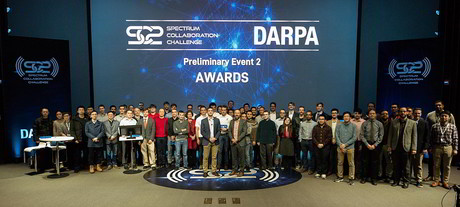Spectrum challenge in the 'colosseum'

Six teams have each been awarded US$750,000 in a spectrum collaboration challenge that showcases the future of autonomous spectrum management.
On 12 December, the US Defense Advanced Research Projects Agency (DARPA) held the second preliminary event of the Spectrum Collaboration Challenge (SC2) — the world’s first collaborative machine-intelligence competition to overcome spectrum scarcity.
Fifteen teams represented by members from across the academic, commercial and defence landscapes gathered at Johns Hopkins University Applied Physics Laboratory (APL) to pit their intelligent radio designs against each other in a head-to-head competition.
At the event’s conclusion, six of the eight top-scoring teams walked away with US$750,000 each in prize money. While not all competitors received interim prizes, all 15 teams have an opportunity to move on to the next stage and compete in the 2019 Spectrum Collaboration Challenge grand finale, which will be held in conjunction with MWC19 Los Angeles, in partnership with CTIA, on 23 October, 2019.
The six prize-winning teams from the second preliminary event are:
- Zylinium, a team of independent researchers
- MarmotE from Vanderbilt University
- Sprite from Northeastern University
- Erebus, a team of independent researchers
- Gator Wings from University of Florida
- SCATTER from IDLab, an imec research group at Ghent University and University of Antwerp, and Rutgers University
“During the second preliminary event we witnessed a technological shift,” said Paul Tilghman, the DARPA program manager leading SC2. “For the first time, we saw autonomous collaboration outperform the status quo for spectrum management.”
Starting in early December, each team’s radio participated in 105 matches against competitors in the Colosseum, a massive RF testbed that was developed specifically for SC2. The matches were held in a round-robin fashion where each radio network — working in groups of threes, fours or fives — had multiple opportunities to compete against every other radio design in the competition.
Roughly 400 matches were held in total to determine the final team rankings and the prize recipients.
During the PE2 matches, teams were put through six different RF scenarios designed to mimic the challenges that collaborative, autonomous radios will face in the real world. These scenarios challenged the radios to collaboratively mitigate interfering with an incumbent radio system, sense and adapt to the spectrum demands of high-traffic environments, handle the data demands of the connected soldier of the future, and more.
Each scenario was designed to pressure test various elements of the teams’ approaches and, in particular, their ability to successfully collaborate with the other radios operating within the same environment.
“The six different scenarios were closely aligned to actual situations that our defence and commercial systems face in the field,” said Tilghman.
“The Wildfire scenario, for example, replicates the complex communications environment that surrounds an emergency response situation, while the Alleys of Austin scenario was designed to mimic what’s needed to help dismounted soldiers navigate and communicate as they sweep through an urban environment.
“This real-world relevance was critical for us as we want to ensure these technologies can continue to develop after the event and can transition to commercial and/or military applications,” added Tilghman.
The sixth scenario of the competition was used to determine the six prize-winning teams. This scenario explored the essential question of the SC2 competition: can the top teams’ collaborative SC2 radios outperform the status quo of static allocation?
Each of the six teams that received awards at PE2 demonstrated that their radio was capable of carrying more wireless applications without the aid of a handcrafted spectrum plan, while simultaneously ensuring four other radio networks operating in the same area had improved performance.
In short, each of these six radio networks demonstrated the autonomous future of the spectrum.
To aid with decision-making, teams applied AI and machine learning technologies in various ways. Some leveraged the current generation of AI technologies, like deep learning, while others used more conventional optimisation approaches. There were also a few teams that used first-wave, rule-based AI technologies.
“We’re very encouraged by the results we saw at PE2. The teams’ radios faced new and unexpected scenarios but were still able to demonstrate smart, collaborative decision-making. PE2 showed us that AI and machine learning’s application to wireless spectrum management creates a very real opportunity to rethink our current century-old approach,” said Tilghman.
The competition now enters its third year and moves closer to the finale, which will be held at one of the largest annual technology and telecommunications shows — MWC19 Los Angeles. More than 22,000 attendees from the broad mobile ecosystem and adjacent industry sectors will convene at this three-day event to discuss the current opportunities and future trends shaping the industry.
The SC2 championship event will be held on the keynote stage of MWC19 Los Angeles on 23 October 2019.
At the conclusion of SC2’s finale, three teams will be awarded US$2 million, US$1 million and US$750,000, respectively, for first, second and third place. The real prize, however, will be the promise of a more efficient wireless paradigm in which radio networks autonomously collaborate to determine how the spectrum should be used moment to moment, helping to usher in an era of spectrum abundance.
Please follow us and share on Twitter and Facebook. You can also subscribe for FREE to our weekly newsletter and bimonthly magazine.
Why traditional transformation approaches fail field workers
A critical misstep in traditional transformation strategies is failing to understand the...
RFUANZ report: setting the frequency for success in 2025
Last year brought a lot of internal change for RFUANZ, but the association has hit the ground...
ARCIA update: an extended event calendar for 2025
With the addition of Tasmanian events and a conference in Adelaide in September, 2025 will see...





